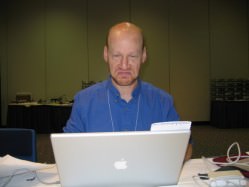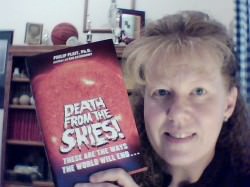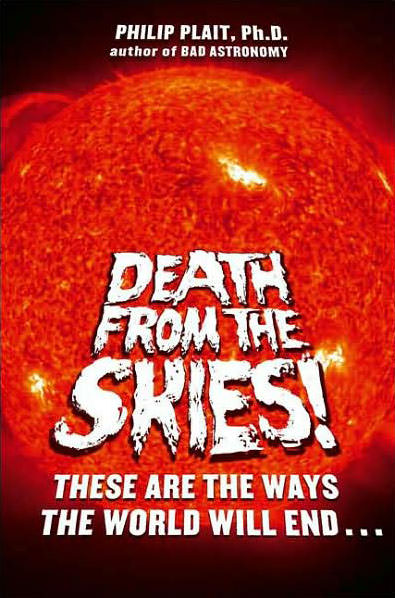[/caption]
This one can be filed under the “Better Late Than Never” department: Writing a review for Phil Plait’s book “Death From the Skies” has been on my to-do list ever since the book came out last fall. Oh, I read the book as soon as it arrived at my door; but making the time to actually write the review has been a challenge. NASA, ESA, all the observatories, NewSpace companies, and everyone else in the space and astronomy business finally got my memo to have a slow news day so I could actually sit down and write this review. But look at it this way: now, my review can be a gentle reminder to anyone out there who hasn’t yet read this book to get the lead out and buy it! So now, without further ado, here’s the review I’ve been meaning to write for months:
I have to say that I’ve learned a lot from Phil Plait, the Bad Astronomer. Even before I met Phil, whenever I had an astronomy question or if I needed back-up on how to deal with someone who, say, didn’t believe NASA landed on the moon in 1969, I always headed to Phil’s Bad Astronomy website and found all the information I needed. Now that I know the BA personally, he still answers my astronomy queries, but I can ask him directly (and he even emails me back!) Also, when I attended my first astronomy conference as a journalist, Phil took me under his wing, showed me the ropes, introduced me to some great folks and told me everything I needed to know. And now after reading his new book, “Death From the Skies: These Are the Ways the World Will End,” I’ve learned one more thing from Phil: you can be laughing and scared out of your wits at the same time.
Actually, I learned a lot more than just that, as Phil packs a huge amount of science in the 307 pages of this, his second book (“Bad Astronomy” is Phil’s first book.) As Phil writes, “Be prepared to stretch your mind a bit.”
For instance, I now know how many gallons of milk would be produced by a supernova, and that experiencing death by asteroid has a 1 in 700,000 chance of happening per lifetime.

I didn’t actually get scared until I was well into the book: chapter 3, which discusses death by supernovae. Something about dead astronauts in the space station made a chill run up my spine. But then, by chapter 4, which tells all about death by gamma ray bursts, Phil soothed my fears by saying, “Are GRBs worth worrying about? One answer is no, because if one goes off there’s nothing we can do about it.” How comforting.
In my mind, the most eerie part was chapter 6, death by aliens. Even the non-malicious or unintended alien visits that possibly brought life to planet Earth are the same forces that could perhaps take it all away.
But really, Phil didn’t write this book to scare anyone. He has a reputation for debunking people who like to create hysteria and prey on people’s fears just to make a buck or a name for themselves. So, in this book, the Bad Astronomer uses equal amounts of facts and humor (approximately) to calmly explain the scientific details of how our Universe works and what it would take for things to go horribly wrong. But he also makes it clear how infinitesimally small the chances are of these events actually occurring. Plus, the option with the highest chance, death by asteroid, is something we Earthlings could potentially counteract, and he admonishes us to get on the stick and start planning for the inevitable. “We spend billions on terrorism, but the risk of an asteroid impact is actually higher,” Phil writes.
Each chapter starts with a short vignette of what could possibly happen to humans on Earth during the different disaster scenarios. Any Hollywood producers who have read “Death From the Skies” must be drooling, as Phil has just handed them potential scripts for seven different disaster movies. Some events are indeed possible in our lifetimes. Others will definitely happen, but none of us (or perhaps any humans at all) will be around for events like the collapse of the sun, the collision of the Milky Way and Andromeda galaxies, and ultimately, the complete death of the Universe.

But Phil makes learning more about all these events great fun, if not a mind-bending experience. Some of the concepts, like black holes and quantum mechanics, defy common sense. As Phil writes, “Get used to that. Your common sense is going to take a beating here.”
However, all these topics make excellent platforms from which Phil can teach us all, and pass on his understanding of the cosmos. So, what sounds scary on the surface is actually enjoyable and informative, and can leave you with a sense of wonder about our amazing Universe.
So if you haven’t yet read “Death From the Skies,” hurry before one of these seven deadly cosmological events actually takes place. But watch out. If the Universe doesn’t kill you, Phil’s puns may do the job. But dying from laughter is a great way to go.


I had the opportunity to read this book last month and it is certainly a masterful work. I only wish it could be a standard reading requirement for everyone in 9th grade – not only debunks bad science but gives you a quality explanation of how the real universe works! This is a book that I heartily recommend to anyone who wants a basic easy to read astronomy short course with no junk!
I think this is one of those times when the movie might actually be better than book 😛
But why not just make one big awesome death from above type movie out of this one?!?!?!
Making “Death from Above” as a campy 50’s style movie would be a hoot! As long as all the science was accurate.
Calling MST3K….
Ordered mine from Amazon – not available from the high street bookshops (not even to order!).
Looking forward to having a good read!
(…in the UK that is!)
I just got my copy from Amazon last week. I have already read through the first few chapters. It is well written, simple and informative. It should be accessible to scientists and laypeople alike. Well done. I do have a copy of his first book and like it as well, but this one is definitely a cut or two better. I would definitely recommend it. My wife is not a scientiest, but already taken an interest in it and plans to read it once I am done with it.